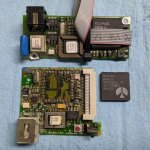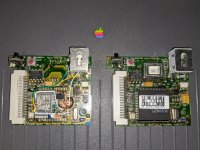sutekh
Well-known member
When I previously expressed interest in developing an ESP8266 wifi modem replacement for the Duo, @techknight correctly pointed out that the "modem" board on the Duo serves other purposes (e.g., the power switches) and the much larger connector isn't just a glorified RS-232 port. Furthermore, the Duo's Developer's Note is much more vague than it's 1xx companion and doesn't include connector pinout info. In short, building a replacement would require a fair amount of reverse engineering beyond the capability of this occasional hobbyist, so aside from buying a spare modem module from a recycler to play with, I tabled the idea.
Fast forward a couple months, I have a bunch of spare PB 1xx Global Village modems sitting loose as a result of an ongoing project to develop a wifi modem replacement for that series of laptops (thread over in hacks), and I happened to notice something: They use the exact same Rockwell chipset as my Duo 280c. Interesting... I know from experience I can get a PB 180 to speak AT to an ESP8266 serial wifi chip in place of the original Rockwell RCV144DPL equipped Global Village. I may not be able to easily design a complete Duo replacement modem board, but that doesn't mean I can't try to modify an existing one!
I lifted the Rockwell chip, grabbed the datasheet, took some measurements, and started plotting a course:

Here's what emerged a few hours later:

Pretty straightforward. Just an ESP-07 joined to a small piece of perf board containing a 3.3v regulator, a divider for RX, and a couple of pull-up resistors, all of which is double-stick tapped to the module. I repurposed the RJ-11 to make RX / TX / GND / GP0 externally accessible for the purpose of external testing and programming.
All in, it's no taller and has a slightly smaller footprint than the original chip. Here are the two side-by-side:

But, and it's a big but, it doesn't work... yet I can communicate with the ESP-07 using an FTDI to RJ-11 dongle I built, but when I try to open the port in MacTerm, it says the selected port is unavailable and power manager never supplies 5vdc. It's that last bit that I think is most telling. If power were being supplied, some logic from the now removed chip not being received, and then powered off in error, that'd be one thing, but the fact that it never even blips suggests to me that one or more of the pins needs to be connected to something or grounded. I'll keep pouring over the datasheet and metering it against the unmolested example...
I can communicate with the ESP-07 using an FTDI to RJ-11 dongle I built, but when I try to open the port in MacTerm, it says the selected port is unavailable and power manager never supplies 5vdc. It's that last bit that I think is most telling. If power were being supplied, some logic from the now removed chip not being received, and then powered off in error, that'd be one thing, but the fact that it never even blips suggests to me that one or more of the pins needs to be connected to something or grounded. I'll keep pouring over the datasheet and metering it against the unmolested example...
Fast forward a couple months, I have a bunch of spare PB 1xx Global Village modems sitting loose as a result of an ongoing project to develop a wifi modem replacement for that series of laptops (thread over in hacks), and I happened to notice something: They use the exact same Rockwell chipset as my Duo 280c. Interesting... I know from experience I can get a PB 180 to speak AT to an ESP8266 serial wifi chip in place of the original Rockwell RCV144DPL equipped Global Village. I may not be able to easily design a complete Duo replacement modem board, but that doesn't mean I can't try to modify an existing one!
I lifted the Rockwell chip, grabbed the datasheet, took some measurements, and started plotting a course:

Here's what emerged a few hours later:

Pretty straightforward. Just an ESP-07 joined to a small piece of perf board containing a 3.3v regulator, a divider for RX, and a couple of pull-up resistors, all of which is double-stick tapped to the module. I repurposed the RJ-11 to make RX / TX / GND / GP0 externally accessible for the purpose of external testing and programming.
All in, it's no taller and has a slightly smaller footprint than the original chip. Here are the two side-by-side:

But, and it's a big but, it doesn't work... yet
